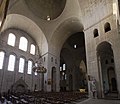Périgueux Cathedral
The Roman Catholic cathedral Saint-Front in Périgueux in the French Dordogne department is the episcopal church of the diocese of Périgueux . The church received in 1897 from Pope Leo XIII. the title of a papal minor basilica and has been part of the UNESCO World Heritage “Camino de Santiago in France” since 1998 .
It should not be confused with the former cathedral of St. Étienne-de-la-Cité in Périgueux, which served as the episcopal church until 1699.
description
The cathedral is dedicated to Saint Fronto of Périgueux , who is said to have worked as a missionary in the Dordogne, according to tradition. In his honor, a church was built in the 6th century, which developed into a place of pilgrimage. In the 11th century there was a large abbey that looked after the pilgrims. The visit was also recommended to pilgrims on the Via Lemovicensis , a French section of the Camino de Santiago to Santiago de Compostela , in the Book of Jacob , which was written at that time .
In the twelfth century the abbey and the old church were abandoned after a military raid and replaced by the current cathedral, the completion of which is dated around 1170. It is speculated that both churches were temporarily connected and shared the same altar with the tomb of Saint Front. The old church now forms the basis of the 60 meter high church tower in the west wing.
The cathedral was built in a style that mixes Romanesque and Byzantine elements. The church has the shape of a Greek (isosceles) cross and is crowned as a cross- domed church with five domes, each 13 meters in diameter. It is similar to St. Mark's Basilica in Venice .
In the 14th century, a flight of stairs on the east side was demolished to make way for an apse chapel in the Gothic style. Originally this was separated from the church by a wall. Today it is integrated to make room for the high altar.
Two burial chapels are attached to the side of the west wing, the northern one probably from the 13th century, the southern one from the 9th century. This is followed by the cloister of the former monastery.
restoration
Between 1852 and 1895 the cathedral was restored by Paul Abadie . This replaced the domes that threatened to collapse, enlarged them on the outside and also provided them with numerous viewing towers. Only the church tower remained unchanged from the original structure. The same architect later built the Sacré-Cœur Basilica in Paris in a similar style .
gallery
organ
The history of the organs goes back to 1733, when the first organ was completed by the organ builder Martin Carouge (1667–1735) from Paris. Today's main organ was built in 1870 by the organ builder Merklin-Schütze and acquired by the cathedral in 1875. The three-manual instrument has remained incomplete to this day. It has 31 stops on two manuals . The actions are mechanical (with Barker machines ).
|
|
|
|||||||||||||||||||||||||||||||||||||||||||||||||||||||||||||||||||||||||||||||||||||||||||||||||||||||||
- Coupling: II / I, II / II (sub-octave coupling); I / P, II / P
The choir organ was built in 1901 by the organ builder Mutin. The instrument has 17 stops on two manuals and a pedal. The actions are mechanical.
|
|
|
||||||||||||||||||||||||||||||||||||||||||||||||||||||||||||||||||||||||||
- Coupling: II / I, I / P, II / P
literature
- WHC Nomination Documentation (PDF, 88.9 MB!), Application documents for the nomination as World Heritage, here: section "Périgueux, Cathédrale Saint-Front"
Individual evidence
Web links
Coordinates: 45 ° 11 '2.6 " N , 0 ° 43' 22.6" E












